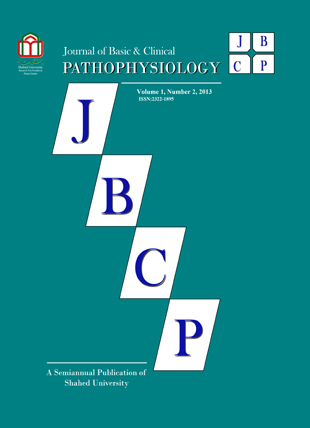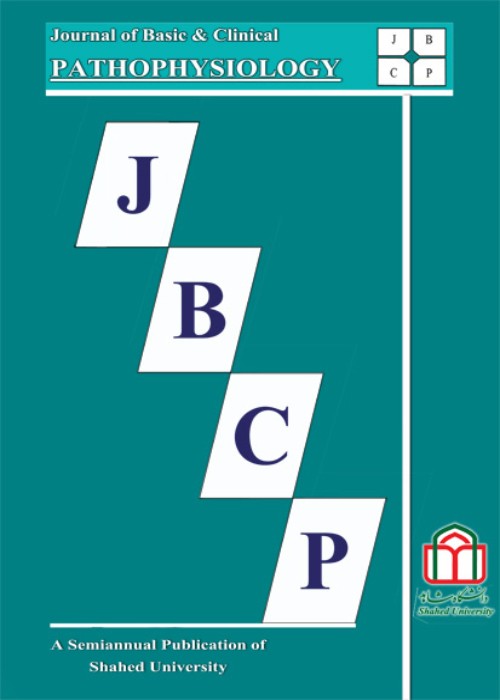فهرست مطالب

Journal of Basic & Clinical Pathophysiology
Volume:1 Issue: 2, Summer-Autumn 2013
- تاریخ انتشار: 1392/09/22
- تعداد عناوین: 8
-
-
Page 1Background And ObjectiveCopper is one of the main micronutrients of body which plays a key role as a cofactor in the function of metabolic enzymes. Previous studies have shown that copper sulfate () inhibits long-term potentiation (LTP) in slices of hippocampal CA1 region. Whereas LTP is involved in learning and epilepsy, it seems that copper effects on LTP could be associated with its effects on epilepsy and seizure. Therefore, the aim of this study was to evaluate the effect of on seizure induced by pentylenetetrazole (PTZ).Materials And MethodsThe effect of various doses of CuSO4 (10, 50 and 100 mg/kg, i.p.), saline (as a control group) or sodium valproate (50, 150 and 100 mg/kg, i.p.) on seizure parameters induced by PTZ (100 mg/kg i.p.) was evaluated in NMRI mice. Twenty minutes after injection of saline or, PTZ (100 mg/kg) was injected to induce seizures in animals and seizure parameters were recorded.ResultsComparison of the effect of, saline or sodium valproate on seizure parameters such as stage 2 latency, stage 5 latency and stage 5 duration showed that dose-dependently reduced seizure.ConclusionThis study showed that significantly inhibits seizure parameters compared with the saline and sodium valproate.Keywords: Copper sulfate Seizure Pentylenetetrazole Valproic acid
-
Page 6Background And ObjectiveEpilepsy is a common disease in communities. Since there is no cure for it and current treatments are not effective for every patient, new method for medical treatment of epileptic patients is necessary. As NMDA receptors antagonists are the most prominent anti-epileptic drugs, in this study we synthesized and investigated anti-epileptic effect of a new piperidine derivate 1-[1-(4-methoxyphenyl) (cyclohexyl)] 4-piperidinol as a new NMDA receptors antagonist in chemical kindling model.Materials And MethodsIn this study, 48 male mice (NMRI), weighting 25-30 g, were selected and randomly divided into 4 groups (n=12 in each group). 1: PTZ 2: 1-[1-(4-Methoxyphenyl) (Cyclohexyl)] 3: piperidinol and 4: valproic acid (positive control). Chemical kindling was induced by PTZ (35 mg/kg, i.p.) injection 11 times one other days (for 22 days). In challenge dose at day 24, PTZ was applied at 75 mg/kg to the animals. Thirty minutes after PTZ injection, the animals were followed for convulsion scores (0-5). Finally, the mean of convulsion phases, threshold and duration of 2 and 5 phases were considered as data and the statistical analysis was done.ResultsData analysis showed that administration of the new piperidine derivate Methoxy-PCP has a prominent anticonvulsant effect than PCP, especially in reduction of phase 5 duration.ConclusionThe results suggest that administration of the new piperidine derivate, 1-[1-(4-Methoxyphenyl) (Cyclohexyl)] 4-piperidinol could yield a prominent anticonvulsant effect in epilepsy. Regarding changes in conformation of the new drug as a non-competitive antagonist, it may potentially block the NMDA receptors than other piperidine derivates.
-
Page 15Background And ObjectiveToday, opioids are used to control and relieve acute and chronic pain. However, the incidence of both tolerance and dependence phenomena for these drugs is a major problem. So, in this study, the combination effect of haloperidol and methadone on the acquisition and expression of morphine dependence and tolerance was examined.Materials And MethodsNinety-eight mice were randomly divided into groups of acquisition and expression. Each group was divided into seven sub-groups, saline, morphine, methadone, haloperidol, haloperidol + methadone, methadone + haloperidol ratio of 2 to 1, methadone + haloperidol ratio of 1 to 2. All groups were addicted with gradually increasing doses of morphine for 7 consecutive days. All drugs in the acquisition group were injected 30 minutes before morphine injected for 7 days and in the expression group 30 minutes before morphine injected in the eight day (test day). Morphine tolerance was measured by tail immersion test for 30 minutes before and after administration of morphine in test day. To assess dependence, mice were administered with naloxone and withdrawal behaviors were observed for 30 minutes.ResultsChronic morphine injections induced tolerance and dependence in mice. Percentage of MPE as a tolerance index was significantly increased in acquisition and expression groups in drugs combination methadone1+haloperidol2 than morphine ones. Also, in dependence group, a marked decrease was shown in withdrawal behaviors in the combination therapy groups.ConclusionOur results showed that probably methadone and haloperidol combination treatment, especially at a ratio of 1 to 2, could reduce tolerance and dependence more than single drug treatment in animal groups.Keywords: Tolerance Dependence Morphine Methadone Haloperidol
-
Page 23Background And ObjectiveParkinson’s disease (PD) is a rather common neurological disorder in elders that is due to degeneration of dopaminergic neurons within mesencephalic substantia nigra pars compacta. With regard to protective and antioxidant effect of simvastatin, this study was conducted to evaluate its neuroprotective effect in an experimental model of PD.Materials And MethodsIn this experimental study, male rats (n =40) were divided into 5 groups, i.e. sham-operated, simvastatin20-treated sham-operated, lesioned and simvastatin10 and simvastatin20-treated lesioned groups. The hemi-PD early model was induced by unilateral intrastriatal injection of l of saline-ascorbate; left side). Theg/56-hydroxydopamine (6-OHDA, 12.5 treated sham and lesioned groups received simvastatin i.p. at doses of 10 and 20 mg/kg once a day before surgery for two times at an interval of 24 h. Two weeks after surgery, the animals were tested for rotational behavior by apomorphine for an hour and the number of dopaminergic neurons in the substantia nigra pars compacta (SNC) was counted.ResultsTwo weeks after surgery, apomorphine caused a significant contralateral turning (PConclusionIntraperitoneal administration of simvastatin exhibits neuroprotective effect against 6-OHDA toxicity in an experimental model of PD, as was shown by a lower rotational behavior and attenuation of neuronal loss.Keywords: Simvastatin Parkinson's disease 6, hydroxydopamine Rotational behavior Apomorphine Substantia nigra
-
Page 29Background And ObjectiveUterus of rat with polycystic ovary (PCO) may show pathological features. We provided pathological evidence for the rat uterus with NO-induced PCO.Materials And MethodsWistar rats (weighing 200-250 g) were kept diestrous to receive L-arginine (50 mg/kg) intraperitoneally (i.p.) for 9 days/once a day. Control group solely received saline (1 ml/kg, 9 days/once per day). At the end of the treatment period, all animals were surgically studied. The rats’ ovaries and uteri were examined biometrically and collected in 10% formalin. The pathological data were collectively determined.ResultsThe treated ovaries of rats showed polycystic characteristics when compared with the control. The uteri of treated rats also showed pathological changes as compared to those that belonged to the controls.ConclusionThe pathological aspect of rat uterus may be linked with the cystic characteristic of ovary in PCO model. This study provides pathological evidence for uterus of rat with PCO.Keywords: L, Arginine Polycystic ovary Pathological evidence Uterus
-
Page 34Background And ObjectiveTeucrium polium (TP) has shown hypoglycemic effect in type 1 diabetes induced by single high dose of the cytotoxic agent streptozotocin (STZ) in rats. This study was conducted to evaluate whether its aqueous extract could have such an effect in multiple low-dose STZ-induced model of type 1 diabetes in rats.Materials And MethodsMale Wistar rats were divided into control, TP-treated control, diabetic, TP-treated diabetic groups. For induction of autoimmune model of type-1 diabetes, streptozotcin (STZ) was administered at a dose of 20 mg/kg/day for 5 days (multiple low-dose; MLD). Aqueous extract of TP was administered at a dose of 100 mg/kg for 3 weeks, started on 4th day post-STZ injection. Serum glucose level was determined before the study and at 2nd and 4th weeks after the study.ResultsTP extract-treated rats had a significantly higher weight versus diabetic rats at 4th week (ConclusionSubchronic TP aqueous extract treatment of rats with autoimmune model of diabetes could attenuate abnormal changes in serm glucose and this may be of potential benefit in patients with type 1 diabetes.
-
Page 39Background And ObjectiveAlleviation of serum glucose level and lipid profile in diabetic patients using herbal medications is of great importance. In the present study, the effect of oral consumption of olive leaves on serum glucose level and lipid profile was investigated.Materials And MethodsMale Wistar rats were divided into four groups including control, control under treatment, diabetic and diabetic under treatment. A single dose of streptozocin (60 mg/kg) was used to induce diabetes in rats. The two groups under treatment were fed with olive leaves powder mixed with the standard food at a ratio of 6.25% for 6 weeks. Serum glucose level and lipids profile were measured before, and at 3rd and 6th weeks after the treatment.ResultsIn diabetic rats under the treatment with olive leaves, serum glucose level was significantly lower at 6th week as compared to the diabetic rats without treatment.ConclusionOral consumption of olive leaves in experimental model of diabetes had hypoglycemic effect and exerts some beneficial changes in lipid profile.Keywords: Olive Diabetes mellitus Glucose Lipid
-
Page 45Background And ObjectiveTraditional Iranian Medicine (TIM) has a long history in the field of diagnosis and treatment of various diseases, particularly addiction. Different therapeutic methods have been recommended in this respect. One of these methods is the replacement of natural narcotics instead of opium. Hab-o Shefa is a natural product of TIM which has been used as an alternative for opium in the treatment of addiction since centuries ago. In this study, the effect of Hab-o Shefa was investigated on behavioral quantities of morphine withdrawal syndrome.Materials And MethodsA total of 30 rats were divided into three groups of ten cases each. The control group received solely morphine at a dosage of 10 mg/kg daily for 8 days by the intraperitoneal route. In the second group, in addition to morphin with the same dosage, methadone at the dosage of 25 mg/kg was daily administered by gavage. Hab-o Shefa at a dosage of 2000 mg/kg through gavage was administered in addition to 10 mg/kg of morphine daily for the third group. Finally and 4 to 24 hours after the last injection of morphine, naloxone was injected i.p. at a dosage of 2.5 mg/kg and the desired withdrawal parameters were evaluated.ResultsConsidering uncountable parameters, a significant difference was seen when comparing methadone and Hab-o Shefa with placebo in regarding diarrhea symptoms (pConclusionIn summary, Hab-o Shefa better controlled the withdrawal symptoms in comparison with placebo and it also better improved the symptoms of diarrhea and salivation as compared to methadone.Keywords: Hab, o Shefa Morphine Traditional Iranian Medicine Withdrawal symptoms


